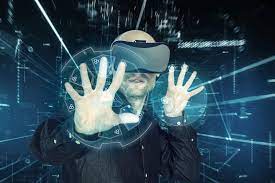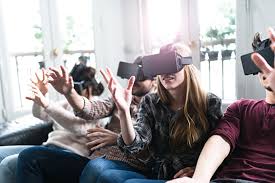The next big tech phenomena
WHAT IS METAVERSE
The Metaverse is an enormously graded and integrated network of real-time delivered 3D virtual realms that can be encountered simultaneously and insistently by an effectively infinite number of users, each with their own sense of presence and data such as individuality, background, welfare benefits, objects, communications, and payouts.
What does Facebook mean by the term “metaverse”?
On October 28, 2021, Facebook announced that it had renamed Meta Platforms Inc., or Meta for brief, a name it deliberately chose to monetize on what will undoubtedly be the inevitable future of global connectivity and, possibly, of life itself.

“A sense of presence — as if you’re right there with another person or in another place — will become the defining trait of the metaverse.” The ultimate goal of social technology is to feel fully present with another person. That is why, following the announcement, CEO Mark Zuckerberg wrote in his Founder’s Letter, “We are focused on developing this.” In a 77-minute webcast, Zuckerberg went even farther, giving millions of people around the world a glimpse into what the metaverse will look and feel like.
Another major Big Tech player, Microsoft, is attempting to create a metaverse. Mesh is the name of the concept. “Holoportation,” as the business puts it, is one of its most intriguing aspects. Simply, users will be able to project holographic versions of themselves onto other users.
Its virtual and augmented realities are best experienced with HoloLens devices, a one-of-a-kind technology that can completely transform the ‘Holoportation’ experience. Mesh, on the other hand, can be accessed using VR headsets, mobile phones, tablets, or computers.
Roblox and Fortnite are two more advanced metaverse platforms. The former is really intriguing.
Roblox, which debuted in 2006 and has since grown in popularity to the point where more than half of all American children under the age of 16 played it in 2020, is more than simply a game.
As an example, consider a fair where guests can play games at stalls. In the virtual world, Roblox is similar to a gigantic fair. Its users can create and monetize their own games on the site by exchanging the virtual currency known as Robux that they earn on the network for real money.
Have we already had a glimpse of the metaverse?
Gamers that are serious about their hobby may attest to this. When it was first released in 2000, The Sims, one of the most well-known games of all time, allowed players to experience a life simulation through their virtual avatars. Its numerous sequels and spin-offs have only added to the overall immersion of “living in virtual reality.”
The Sims provided a sneak peek into what a future metaverse experience would be like. Second Life was created by Linden Lab, an American technology corporation, in 2003. Virtual reality enthusiasts and professionals alike credit Second Life with technically sowing the metaverse’s seeds.
Second Life gives its users the opportunity to live a second life, as the name implies. On the platform, actual people may build 3D virtual avatars and accomplish practically everything they can in the real world.
Second Life is a virtual environment where people can communicate with one another and build relationships using their virtual identities. They can plan events, attend them, and express themselves through music and art, as well as interact with virtual objects in the area and even help create virtual structures in Second Life. Religious courses, concerts, and business meetings are all available to them.
There are other educational institutions and embassies to consider. The Maldives was the first government to establish a virtual embassy in Second Life in 2007.
Second Life’s closed-loop digital currency, the Linden Dollar (not to be confused with a cryptocurrency), can be used to resell virtual objects. Players can engage with each other in a number of games, including the multiplayer online role-playing game World of Warcraft, which was debuted in 2004. This is a type of social network where people establish communities around games.

AR and VR shaping the metaverse
The introduction of virtual reality headsets such as Oculus has given the metaverse a big boost. Games designed specifically for virtual reality headsets are already generating a lot of revenue. From USD 7.92 billion in 2021 to USD 53.44 billion in 2028, the worldwide virtual reality gaming market is expected to rise to USD 53.44 billion.
AR takes it a step further by enhancing the user’s sense of reality through the use of technology. It’s similar to gaining more information about a real-world object while seeing it through an AR gadget or headset.
Returning to the Marvel Cinematic Universe (MCU) flicks featuring Iron Man is a traditional approach to grasp this. Tony Stark (aka our favorite Iron Man) played by Robert Downey Jr. revealed technology that is still beyond our wildest dreams. There are various moments in which he is wearing the Iron Man suit and receiving information and various visualizations of things that he is viewing in real-time on his heads-up display (HUD). That is, to a large extent, AR. After all, these are movies, and Iron Man enters regions of extremely advanced technology that will take decades to reach reality.
The speed with which the actual world is attempting to make VR/AR and the metaverse a reality is, however, remarkable. Apple Inc. has already gotten into augmented reality, claiming to have “the world’s largest AR platform.” Several AR apps are available on the App Store, and they may be used for everything from making Snapchat videos more entertaining to examining 3D projects in AR. Nreal, a Chinese augmented reality firm, released the Nreal Light glasses in 2020 and will begin distributing the Nreal Air glasses to China, Japan, and South Korea in December 2021. Furthermore, consumer augmented reality glasses resemble conventional luxury fashion shades, making the enhanced reality experience more thrilling.
The speed with which the actual world is attempting to make VR/AR and the metaverse a reality is, however, remarkable. Apple Inc. has already gotten into augmented reality, claiming to have “the world’s largest AR platform.” Several AR apps are available on the App Store, and they may be used for everything from making Snapchat videos more entertaining to examining 3D projects in AR.
Nreal, a Chinese augmented reality firm, released the Nreal Light glasses in 2020 and will begin distributing the Nreal Air glasses to China, Japan, and South Korea in December 2021. Furthermore, consumer augmented reality glasses resemble conventional luxury fashion shades, making the enhanced reality experience more thrilling.
How will Metaverse shape the future?
Almost everyone wanted to be a pioneer in the meta-universe when it was first created. On Decentraland, Coca-Cola launched a one-of-a-kind collection of blockchain-based content. You can engage in NFT auctions and win items like friendship cards or sound players that replicate the opening of a Coca-Cola can as part of your online activity.
On the website Roblox, Gucci declared its arrival in the meta-universe and sold its digital package for $4,115. NFT certification has been obtained by the owner. It’s worth noting that this bag is more expensive than its physical counterpart, which retails for $3,400 in stores. This appears to be the case today, albeit few women may appreciate NFT bags on their birthdays.
From an investing standpoint, Metaverse opens up a slew of new possibilities in the digital real estate market, while simultaneously boosting the value of current technological businesses (Facebook, Tencent, Microsoft, and so on) who are comfortable in the space. Non-tech enterprises, on the other hand, that can benefit from the resource needs of sales and marketing prospects (Coca-Cola, marketing firms) or infrastructure (Nvidia, Qualcomm, and so on) will find chances in Metaverse. New businesses can start from the ground up and continue to flourish in the future. Initial Public Offering (IPO) Success (Decentraland etc.).
The value of some Crypto and the entire NFT market may rise as a result of the meta-universe. It has the potential to save expenses and improve the efficiency of businesses. NFT, blockchain, and cryptocurrency all point to the meta world. Of course, there are additional investing prospects in Metaverse. These prospects aren’t as evident as they formerly were. These opportunities will emerge as the future unfolds. In the digital world, the Metaverse may have its own capital market.
Investment firms, venture capital firms, SPACs, funds, and small investors will be interested in Metaverse’s tales and investment prospects, which offer high valuations and potential returns.
The most widespread misconception regarding Metaverse is that it is a decentralized and interoperable platform, similar to the Internet, on which numerous businesses operate. However, this necessitates the ability to exchange acquired assets (land, property, artwork, and currency) between different locations, which NFT and blockchain systems can facilitate.
The company’s marketing activities will be raised to a whole new level, based on the current scenario. A constantly targeted advertisement can be presented to us through our room, which is more complicated than using Instagram to tell the tale (it’s already more complicated than TV commercials).
Metaverse will undoubtedly revolutionize the social media environment, given its ability to fundamentally change our lives. Marketing and the creator economy are two of the most fascinating and exciting aspects of the new world. Advertisers will have access to more data than ever before, and complicated placement will be taken to new heights. The information will be more precise and valuable. Brands will need to establish digital twins and either follow or control the meta. The universe’s latest fad. Some have already taken action, and powerful people might consider developing avatars in the meta-universe and collaborating with brands.
Meta universe gives creators a new method to interact and communicate with their fans and influencers. Food KOLs can cook with followers, travel specialists can share their experiences, sports KOLs will be surrounded by their supporters, and so on. This is a playground with almost no boundaries on this topic, allowing all players, whether important individuals or businesses, to become pioneers, inventors, and creative geniuses.
Meta Universe opens up a world of possibilities for global marketers, and it may be used in practically any business. Influencer marketing, on the other hand, appears to be on the rise in the digital era. Meta Universe, which is as crowded as the internet celebrity sector, now allows everyone to begin their internet-famous path. Simultaneously, it allows established personalities to build two identities in the digital domain, and the brand will attempt to consolidate their Innovation and prestige; after all, fashion firms want to stay ahead of the competition.
Blackcoffer Insights 37: Khushboo Rajput, NARAYANA BUSINESS SCHOOL AHMEDABAD



